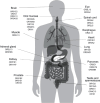Olfactory receptors in neural regeneration in the central nervous system
- PMID: 39503417
- PMCID: PMC11801295
- DOI: 10.4103/NRR.NRR-D-24-00495
Olfactory receptors in neural regeneration in the central nervous system
Abstract
Olfactory receptors are crucial for detecting odors and play a vital role in our sense of smell, influencing behaviors from food choices to emotional memories. These receptors also contribute to our perception of flavor and have potential applications in medical diagnostics and environmental monitoring. The ability of the olfactory system to regenerate its sensory neurons provides a unique model to study neural regeneration, a phenomenon largely absent in the central nervous system. Insights gained from how olfactory neurons continuously replace themselves and reestablish functional connections can provide strategies to promote similar regenerative processes in the central nervous system, where damage often results in permanent deficits. Understanding the molecular and cellular mechanisms underpinning olfactory neuron regeneration could pave the way for developing therapeutic approaches to treat spinal cord injuries and neurodegenerative diseases like Alzheimer's disease. Olfactory receptors are found in almost any cell of every organ/tissue of the mammalian body. This ectopic expression provides insights into the chemical structures that can activate olfactory receptors. In addition to odors, olfactory receptors in ectopic expression may respond to endogenous compounds and molecules produced by mucosal colonizing microbiota. The analysis of the function of olfactory receptors in ectopic expression provides valuable information on the signaling pathway engaged upon receptor activation and the receptor's role in proliferation and cell differentiation mechanisms. This review explores the ectopic expression of olfactory receptors and the role they may play in neural regeneration within the central nervous system, with particular attention to compounds that can activate these receptors to initiate regenerative processes. Evidence suggests that olfactory receptors could serve as potential therapeutic targets for enhancing neural repair and recovery following central nervous system injuries.
Copyright © 2025 Copyright: © 2025 Neural Regeneration Research.
Conflict of interest statement
Figures

Similar articles
-
The Olfactory Trail of Neurodegenerative Diseases.Cells. 2024 Apr 2;13(7):615. doi: 10.3390/cells13070615. Cells. 2024. PMID: 38607054 Free PMC article. Review.
-
The loss of scents: do defects in olfactory sensory neuron development underlie human disease?Birth Defects Res C Embryo Today. 2015 Jun;105(2):114-25. doi: 10.1002/bdrc.21094. Epub 2015 Jun 25. Birth Defects Res C Embryo Today. 2015. PMID: 26111003 Review.
-
Olfactory ensheathing glia: their contribution to primary olfactory nervous system regeneration and their regenerative potential following transplantation into the injured spinal cord.Brain Res Rev. 2007 Nov;56(1):236-58. doi: 10.1016/j.brainresrev.2007.07.013. Epub 2007 Aug 14. Brain Res Rev. 2007. PMID: 17884174 Review.
-
Optical control of ERK and AKT signaling promotes axon regeneration and functional recovery of PNS and CNS in Drosophila.Elife. 2020 Oct 6;9:e57395. doi: 10.7554/eLife.57395. Elife. 2020. PMID: 33021199 Free PMC article.
-
Understanding the neural repair-promoting properties of olfactory ensheathing cells.Exp Neurol. 2014 Nov;261:594-609. doi: 10.1016/j.expneurol.2014.05.007. Epub 2014 May 17. Exp Neurol. 2014. PMID: 24842489 Review.
Cited by
-
Genome-Wide Association Study and Rare Variant Association Studies of Strabismus in the All of Us Research Program.Ophthalmol Sci. 2025 Jul 1;5(6):100873. doi: 10.1016/j.xops.2025.100873. eCollection 2025 Nov-Dec. Ophthalmol Sci. 2025. PMID: 40837069 Free PMC article.
-
The mysterious sense of smell: evolution, historical perspectives, and neurological disorders.Front Hum Neurosci. 2025 Jun 13;19:1588935. doi: 10.3389/fnhum.2025.1588935. eCollection 2025. Front Hum Neurosci. 2025. PMID: 40584825 Free PMC article. Review.
References
-
- Ache BW, Young JM. Olfaction: diverse species, conserved principles. Neuron. 2005;48:417–430. - PubMed
-
- Alexander SPH, et al. The Concise Guide to PHARMACOLOGY 2023/24: G protein-coupled receptors. Br J Pharmacol. 2023;180(Suppl 2):S23–144. - PubMed
-
- Angulo E, Casadó V, Mallol J, Canela EI, Viñals F, Ferrer I, Lluis C, Franco R. A1 adenosine receptors accumulate in neurodegenerative structures in Alzheimer disease and mediate both amyloid precursor protein processing and tau phosphorylation and translocation. Brain Pathol. 2003;13:440–451. - PMC - PubMed
LinkOut - more resources
Full Text Sources
Other Literature Sources

